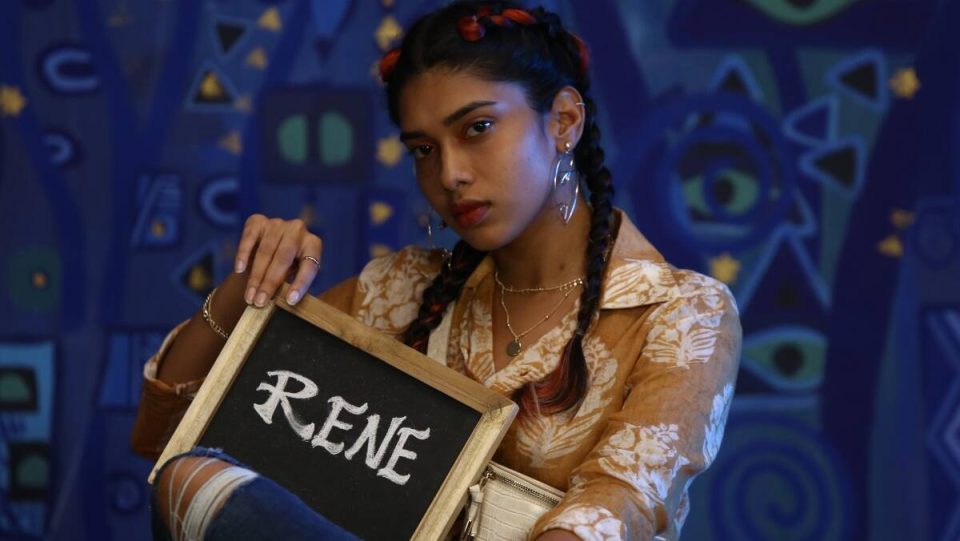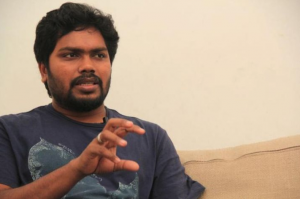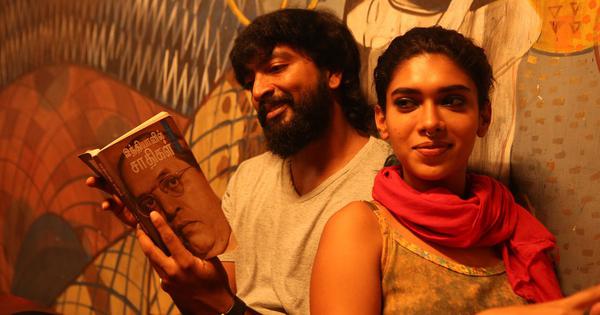
Natchathiram Nagargiradhu: Rewriting Dalit identity politics, and conventions

Dalit iconography has always played a significant part in Pa. Ranjith’s films ever since he burst on the Tamil cine scene with Attakathi (Cardboard Knife), a romantic slum comedy set in north Chennai, in 2012. The film used walls as a canvas to fill a gap in political representation: a statue and a framed photo of Dr BR Ambedkar, the architect of the Indian Constitution, adorn the premises of a school.
In Kabali (2016), he subtly works in Dalit politics by juxtaposing Ambedkar and Mahatma Gandhi. In Kaala (2018), when a police officer joins a protest and reveals himself as Dalit, there is an eruption of the Bahujan greeting: ‘Jai Bhim.’ Kaala, incidentally, became the first Indian film to showcase a Buddhist colony (Buddha Vihar). Caste nomenclature has consistently hovered in the backdrop of Ranjith’s films, in which the dialogues, too, have references to Ambedkar. In his latest, Natchathiram Nagargiradhu, it takes centre stage.
An Ambedkarite heroine
The heroes in Ranjith’s previous films belong to the Scheduled Caste (SC). In Natchathiram Nagargiradhu, however, he casts an SC girl as his heroine, a rare thing in Kollywood. The movie, thus, has become a trendsetter in uncharted territory. The Tamil film industry has shown heroines as a dark-skinned girl and, thereby, hated by the villagers (Marikozhundhu, 1991); as someone stricken with poverty (Chinna Thayee, 1992); as differently-abled (Mozhi, 2007); and even as a sex worker (Pudhupettai, 2006). But it never had the guts to project the heroine as an SC girl. Or, at least, it didn’t openly name her as a Dalit.

In one of the scenes of Natchathiram Nagargiradhu, a character named Arjun (Kalaiyarasan Harikrishnan), who has developed an interest in the heroine Rene (Dushara Vijayan), asks her whether she is a communist. To this, she calmly replies: “I am an Ambedkarite”. This is well received by the audience and possibly could pave the way for more films in the future to portray SC women as heroines.
Ranjith, in several interviews in the past, shared that when he narrated the script of Attakathi to producers, they invariably advised him to remove the scenes that used Ambedkar’s statue and dialogues with references to him. In the last decade, Ranjith has carved a niche for himself. After his arrival, Tamil cinema has seen Dalit voices getting prominent on the screen. From having been advised to remove Ambedkar’s references to making a heroine say that she is an Ambedkarite, what the 39-year-old filmmaker has achieved is significant and needs to be celebrated.
Also read: Pa Ranjith’s Natchathiram Nagargiradhu: Portraying love through another prism

Breaking stereotypes of love
Natchathiram Nagargiradhu deals with love of all shades: it explores heterosexual love affairs, as well as the ones between transgenders, gays and lesbians. Ranjith delves into the caste politics behind love by touching upon contemporary hate killings in the Ilavarasan-Divya, Shankar-Kowsalya, and Gokulraj cases.
“Though the film is a bit dialogue-heavy and touches upon political issues, it doesn’t come across as preachy. Rather it engages the audience with nuanced humour and interesting treatment of screenplay,” film critic Suresh Kannan told The Federal. Ranjith has displayed a refreshing change, not only in the story, but also in the making of the film. There is a scene in which an animation sequence is used while narrating the flashback of Rene which adds more weight to the character.
Photographer Karthick, who writes under the pseudonym Yathri, said that the character Arjun represents many sections of the audience: casteist, anti-queer, male chauvinist, etc. “There is a scene in which Arjun sexually harasses Rene. But she forgives him saying that everyone is not politically correct all the time and political correctness is a lifelong process. On the other hand, she does not forgive her lover Iniyan (played by Kalidas Jayaram) because he made a casteist slur against her. This shows that harassing one based on his/her caste is more grievous than being sexually assaulted,” he said.
Such a long journey
Ranjith’s accomplishment achieves particular relevance in the 75th year of Independence, when the Indian film industry is set to be close to 110 years. It is hard to forget that it took 38 long years for a portrait of Ambedkar to appear in mainstream films. It was J Om Prakash’s Aakhir Kyon (1985), which became the first Bollywood film to show the framed photograph of Ambedkar hanging on the wall in the backdrop of a scene.
Before Bollywood, it was a Marathi filmmaker who first used the framed portraits of Ambedkar in the backdrops of his films: Jabbar Patel in his 1979 political drama Sinhasan and, subsequently, in Umbartha (1982) and Mukta (1994). After Aakhir Kyon, Bollywood had to wait for another 32 years to show a portrait of Ambedkar in the 2017 film, Amit V. Masurkar’s Newton.
If R. Nataraja Mudaliar’s Keechaka Vadham (1917) is considered to be the first film in Tamil, then the Tamil film industry, too, has crossed hundred years and it is no different in overlooking the legacy of Ambedkar. Therefore, when Ranjith used the backdrop of his 2012 film to allude to the historical icon, he put an end to the 95-year-long erasure in the history of Tamil cinema.
In 2000, Jabbar Patel released the biopic of Ambedkar, Dr. Babasaheb Ambedkar, starring Mammootty. Unfortunately, in many states, including Tamil Nadu, the film’s release was stalled and received a lukewarm response. But, in the preceding decades, Indian language films eschewed Ambedkar’s framed portraits even in court scenes. It is no wonder, then, that the Hollywood film Gandhi (1982) has no reference to Ambedkar.
Also read: George Kutty is back, Mohanlal’s ‘Drishyam 3’ confirmed; fans thrilled
Given the long struggle and politics behind the refusal to use Ambedkar’s portraits, we can realise how difficult it would be to speak about his ideology in mainstream films. While Ranjith persistently bats for Ambedkar’s ideas in his films, Nagraj Manjule does the same in the Marathi film industry. His latest film, Jhund (2022), shows Amitabh Bachchan paying respects to Ambedkar’s statue. It is considered a big leap in Dalit identity politics in cultural space.
“We must understand that today’s space has been created to make such statements by urbanised, JNU-educated men and women in public. This is because of the awareness around Dalit literature and politics which has increased in the last four decades,” said Stalin Rajangam, a researcher on Dalit issues.
Rajangam added that people who talk about Dalit empowerment believe that they should dwell on the ‘glorious past’ of the Dalits. “They think that Dalits should also be projected as ‘Aanda Parambarai’ (a community that ruled others). But Ranjith, who explores Dalit empowerment in his films, continues to make fun of the ‘Aanda Parambarai’ concept. Instead, he has his eyes set on the future of Dalits. In Kabali, there is a dialogue where the hero says: ‘Naan aanda parambarai illa, aala poravan’ (I am not a ruler of the past, but one who will rule the future). Through this, Ranjith hints at the assertion of the Dalits, instead of seeking sympathy. And that makes a difference,” said Rajangam.


